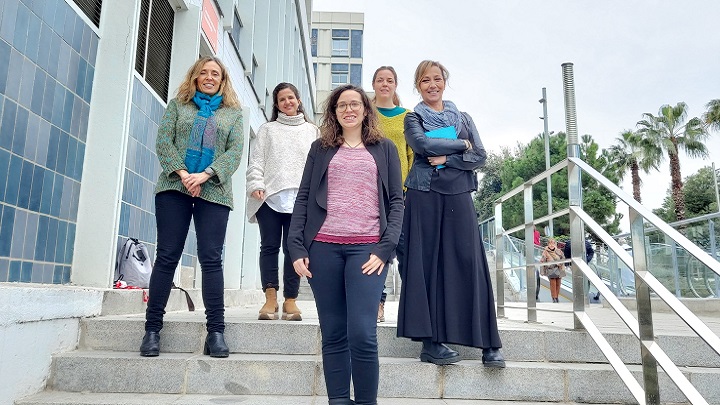Researchers create a stem cell-based model to study an ultra-rare disease that causes infantile parkinsonism

A team of researchers from the University of Barcelona, the Bellvitge Biomedical Research Institute (IDIBELL), the Sant Joan de Déu Research Institute (IRSJD) and the Santa Creu i Sant Pau Research Institute (IIB Sant Pau) have presented in the journal EMBO Molecular Medicine a new model based on human stem cells to study a rare genetic disease affecting children, called tyrosine hydroxylase deficiency (THD).

A team of researchers from the University of Barcelona, the Bellvitge Biomedical Research Institute (IDIBELL), the Sant Joan de Déu Research Institute (IRSJD) and the Santa Creu i Sant Pau Research Institute (IIB Sant Pau) have presented in the journal EMBO Molecular Medicine a new model based on human stem cells to study a rare genetic disease affecting children, called tyrosine hydroxylase deficiency (THD).
The disease causes a significant decrease in dopamine —one of the most important neurotransmitters in the central nervous system— in the brain, leading to infantile Parkinsonism. Some patients improve greatly with treatment, but others are refractory and remain with severe motility symptoms and intellectual disability.
The model created faithfully reproduces the pathological characteristics of the disease: it has been created from patients' skin cells, which have been reprogrammed into pluripotent stem cells capable of becoming any cell type, and subsequently differentiated into neurons.
"The model provides a valuable tool to study the pathogenic mechanisms of this pathology, as well as to develop new therapies to improve patient management. It can even help the implementation of personalised therapies, since not all patients respond to the treatment", says Professor Antonella Consiglio, head of the research group at the Faculty of Medicine and Health Sciences, the Institute of Biomedicine of the University of Barcelona (IBUB) and IDIBELL, ICREA Academy researcher and one of the leaders of the project.
Just like in a physiological level, neurons that are differentiated from the patients' stem cells show very low levels of dopamine. "Moreover, these neurons show morphological defects that had not been detected with other experimental approaches", notes Alba Tristán Noguero, first author of the study and postdoctoral researcher at the Department of Genetics, Microbiology and Statistics of the Faculty of Biology of the UB and the IIB Sant Pau.
The model is also able to reproduce the response to treatment that has been observed in patients: dopamine treatment only reverses symptoms in patients with mild THD, whereas severe patients do not respond to treatment and end up developing cognitive impairment.
As a key finding, the study reveals that in the model that reproduces the most severe condition of THD, early administration of dopamine —when neurons are still differentiating— is able to prevent the effects of the disease. This result suggests that the treatment could work in the most severe patients if given during brain development.
"This is the first THD model capable of reproducing the characteristics of mild and severe patients differentially, and which also reproduces their differential response to treatment", says Àngels García Cazorla, co-leader of the study, professor at the Faculty of Medicine and Health Sciences, group leader at the IRSJD and at the Neurometabolic Diseases Unit of the Hospital Sant Joan de Déu in Barcelona, and member of the Centre for Biomedical Research Network on Rare Diseases (CIBERER).
The study includes the participation of the experts Irene Fernández Carasa, Carlos Calatayud, Arianna Colini Baldeschi, Meritxell Pons Espinal and Ángel Raya (UB-IDIBELL); Cristina Bermejo Casadesús, Mercè Pineda and Rafael Artuch (IRSJD); Leticia Campa, Francesc Artigas and Analia Bortolozzi (IDIBAPS), and Rosario Domingo Jiménez and Salvador Ibáñez (Hospital Virgen de la Arrixaca e Instituto Murciano de Investigación Biosanitaria Virgen de la Arrixaca).
The study is part of a research project on childhood-onset parkinsonism funded by the Fundació La Marató de TV3 in which the researchers Antonella Consiglio and Àngels García Cazorla, co-leaders of this article, participate. The work has also received support from the European Research Council (ERC), the Ministry of Economy and Competitiveness (MINECO), the Ministry of Science and Innovation (MCIN), the European Next Generation funds, the Carlos III Institute of Health (ISCIII), the European Regional Development Fund (ERDF) and the State Research Agency (AEI).
Reference article:
Tristán-Noguero, A; Fernández-Carasa, I. et al. “iPSC-based modeling of THD recapitulates disease phenotypes and reveals neuronal malformation”. EMBO Molecular Medicine, February 2023. Doi: 10.15252/emmm.202215847
